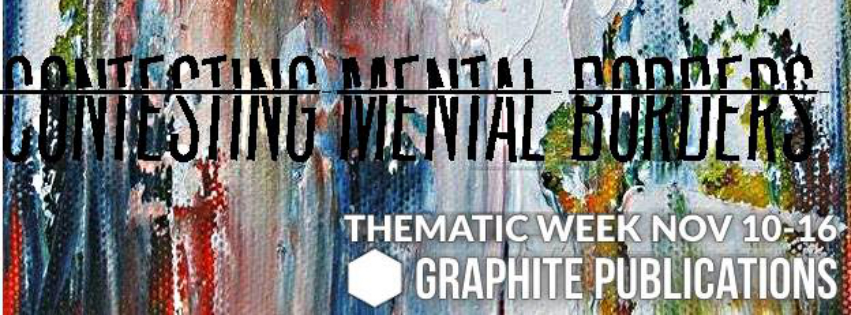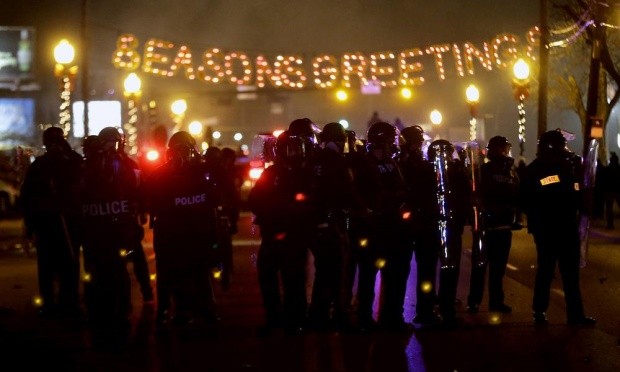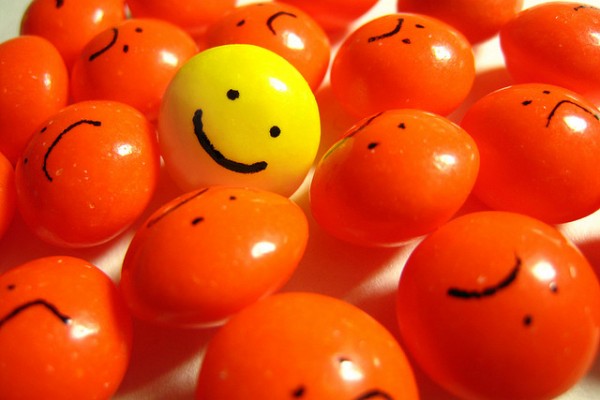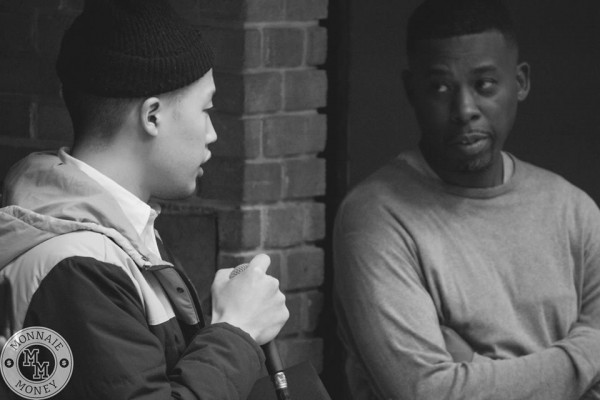After three months of deliberations, and adhering to many people’s gloomy predictions, the Grand Jury deliberating on the case of the shooting of Mike Brown decided not to indict Darren Wilson, the officer who shot and killed unarmed Mike Brown on the 9th of August this year. Despite a call for no protests at night, St Louis Prosecuting Attorney Robert McCulloch decided to wait until 8:00 PM Monday night to announce the Grand Jury decision on the killing of Mike Brown. His forty-five minute speech sounded as if the Grand Jury had found Wilson innocent, and Brown guilty. No indictment means no day in court — the killing of Mike Brown is officially legal. If you watched any of the live streams of the protests you would have heard young black men shouting exactly this at officers: “It’s legal to kill us.” You would have also seen the great heterogeneity in protestors. Some did commit acts of vandalism, others - such as livestreamer Bassem Masri - vocally and physically protected local businesses. Some protesters tipped police cars, others simply stood up for their right to peacefully assemble. All were subject to the same tear gas.
CNN, the BBC, and most other major news sources give the impression that the protests were an anarchic frenzy of looting. In the coming week, this impression is only liable to get worse as footage gets distilled into short, sensational clips in order to fit the dwindling time-slots of the news cycle.
It strikes me as odd that what was emphasized was the looting; CNN and the BBC paid little attention to the many peaceful protests occurring. They decided to go for sensationalism, often arriving at the scene after events had already occurred, only to speculate without any context. Bassem Masri’s livestream clearly showed that the projectiles thrown by a few protesters - rocks and waterbottles for the most part - had little impact on the perspex shields, kevlar armour, helmets, and gas masks worn by the police. Moreover, these projectiles only began to be thrown after a peaceful march was blocked by the police on the premise that the protests were illegal, which is a rather illogical strategy for ensuring the peaceful expression of anger by a community with no voice.
Furthermore, when a few people attempted to vandalize Cathy’s Kitchen and a neighbouring Italian restaurant many of the protestors protected these establishments. In fact, Mr. Masri can be heard on film stating the Italian restaurant owners were “good people.” In this and compared to the vague coverage of ‘looting,’ we see the nuance mainstream media sources often lack; most of the looted shops were corporate, not locally owned- this may have been because the owners were part of the community. The community actively attempted to protect local businesses and has been engaged in attempts to clean up the mess from monday night. It is important that we recognize that last night many Ferguson residents did more to protect local businesses than law enforcement. Despite the fact that the minority of protesters were violent, all choked on tear gas as the police pushed them in the street. Cannisters were thrown back and the police continued firing gas into back yards and parking lots — all this took place in a largely residential neighbourhood. Even if the protesters had followed law enforcement’s commands to return to their homes, they may well have been subject to tear gas in their yards. Only after about five minutes were the protestors able to retreat from advancing police lines to where the reporters were stationed. This is the point a lot of people may have seen reporters outside a precinct get caught in the tear gas barrage.
An obvious initial question for the police is why they thought suiting up like an occupying military force and deploying armoured personnel carriers would result in peaceful and amicable relationship with the community. When you are blocking a street with a police line it is hard to argue that the protesters are the ones blocking traffic. It seemed they wished to defuse and silence the community rather than working with them. If the community is in the streets, whose peace are you protecting by telling them to go home?
The stream ended with the protesters loosely surrounded by police riding military-style vehicles and ordering protesters to disperse, which - being surrounded - seemed like an impossible demand. Every request by various protesters to speak to the commanding officer seemed to be ignored: law enforcement’s strategy seemed to be more geared toward maintaining a zone of power and control rather than any sort of productive interaction with the community.
The protest did not get violent until the police prevented it from progressing. When law enforcement reacted to the violence, they did so neither proportionally, nor selectively. If you want people to protest peacefully one would question the efficacy of punishing people who were peaceful along with those that weren’t. The threat that small stones and water bottles pose to heavily armoured police officers does not amount to a tear gas response. Furthermore, it is perverse to use such brutal tactics to put down protests caused by a community’s maltreatment. Remember that local distrust for local law enforcement far predates the Mike Brown case: the city’s second largest source of revenue was fines and court fees with an average of 1.5 warrants issued per household- 24532 warrantstotal. These warrants would be issued for minor infractions such as jaywalking, hearings often started up to half an hour early and the court doors were often locked 5 minutes after the official proceedings started leading citizens to have to pay additional fines for failure to appear. Additionally, many of these warrants were issued in a format authorizing the police to take the individual to jail the next time they encountered them. Ferguson PD reportedly often used to park outside of polling stations on election days- a transparent an effective means to discourage people from voting. Racial bias is also very much at play here- while Black people made a little less than two thirds of the driving population, they accounted for 86% of all car stops and were twice as likely to have their cars searched. While there were 5348 car stops in Ferguson last year, 4632 were of Black people and while the contraband search rate was double that of white drivers -12.13% versus 6.85%- the actual hit rate- the rate at which actual contraband was found was lower -21.31% versus 34.4%. Despite these statistics the arrest rate of Black drivers was in fact higher again almost double that of White drivers- 10.43% versus 5.25%. It’s clear that the situation in Ferguson extends beyond ‘mere’ over-policing into institutionalized racism.
This systematic disenfranchisement of the people of Ferguson, in light of the fact a Black man is shot in the US every 28 hours by police or vigilantes has created a situation where a people cannot trust the state institutions who claim to be there to serve and protect them. They cannot be represented by a government which they cannot choose, and which acts to prevent them from choosing it. Police departments in North America have historically been used to control minorities- the first police departments were slave patrols and Indian Constables, and it’s dubious that they’ve departed too far from their original mandates. This is the context for these protests — in the words of W.E.B. Dubois, “A system cannot fail those it was never intended to protect.” Perhaps the Ferguson police - and the institution of policing in general- is not failing; perhaps this is what the success of the American justice system looks like.
It is, therefore, noteworthy that these protests are not particularly more violent than the Pumpkin Riots in Keene New Hampshire, or the celebrations in San Francisco after the Giants won the world series that saw a bus set alight. Or - further afield - the riots that Montreal and Vancouver have had over hockey. All in all, the protesters showed admirable amounts of restraint.
Fact is, it is hard to know what we expect from protesters: the media makes violence the only long-term pathway to coverage; its eye-catching, click-bait, pornographic imagery increases viewership and fuels advertising-funded media groups. More and more it seems that we only give people a voice in violence, then we portray events as though they are spontaneous and not the reaction to long-term systemic violence. The only time the public pays attention to Black people getting shot is when there are protests, and then the media focuses on the protests reacting to isolated incidents — the fact is, no-one knows how many people american police kill every year. Consider the dwindling coverage of the Ferguson case over the last months; peaceful protests have been staged daily for the past 108 days, and the story quietly slipped from headlines, until last night.
There doesn’t seem to be that many people seriously questioning the internal logic of McCulloch and Wilson’s narrative: a few cigarillos and shoving a store clerk does not justify the killing of an unarmed person. If armed responses to unarmed civilians are to be considered reasonable, then law enforcement should be trained to take non-fatal shots. Physical evidence does not have a single way it may be interpreted and those interpretations are fallible — often as fallible as eyewitness accounts.
Our obsession with property also neatly sidesteps the question of where the anger is coming from. As Raven Rakia argues in her essay Black Riot, our immediate disapproval of the destruction of property devalues and distracts from the killing which is the original source of the anger. Rather than thinking critically of what would drive the average person to such a display of anger we paint them with universal disapproval. The United States has legalized civil forfeiture, the idea that a piece of property can be forfeit if suspected of being used in, or gained from a crime. What, then, do the people’s rights amount to when the institutions they pay for are profiting from crimes against the people?
The protests will most probably continue, and until the community is allowed to express their (understandable) anger and frustration, until they are allowed to march down their own streets peacefully without being blocked, cordoned and doused in tear gas, I doubt we will see any real resolution.
Update November 25th 11:39 PM
Tonight there are protests concerning the indictment in 37 states as well as outside the US embassy and consulate in Ottawa and Toronto.
In Ferguson an initially peaceful protests are being dispersed by police- protesters were first told to get out of the street and then ordered off the sidewalks as well. Tear gas is again being deployed.
In Minneapolis protesters have been twice rammed by cars.
By Nathaniel McKenzie








CL
“Our obsession with property also neatly sidesteps the question of where the anger is coming from.” That really hits the nail on the head. Great work.